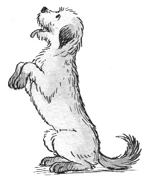
|
|
Dogs and More Dogs
|

|
|
Program Overview
|

|
 NOVA presents the story of dogs and how they evolved into the most
diverse mammals on the planet.
NOVA presents the story of dogs and how they evolved into the most
diverse mammals on the planet.
The program:
-
discusses the evolution and remarkable diversity of dogs.
-
notes that there are currently more than 400 different breeds of
dogs worldwide.
-
relates two competing theories about how dogs were domesticated:
Stone Age humans adopted and selectively bred wolves for
tameness; wolves essentially "chose" domestication when they
began to forage for food near prehistoric dumps. There, tameness
was an advantage.
-
considers why dogs have tails that stick up, droopy ears, and
other traits that are not found in the wolf gene pool.
-
recounts an experiment in which foxes bred for tameness produced
dog-like traits, leading to speculation that the new traits were
due to different levels of hormones created as a byproduct of
tameness.
-
explores how dominance hierarchies in wolf society have
contributed to making dogs well suited to be pets.
-
suggests that dogs specialized in specific
behaviors—hunting, tracking, pointing,
retrieving—and that over thousands of years humans used
food to reward the dogs best at these behaviors. These
better-fed dogs then had an improved chance at surviving and
passing on their genes.
-
proposes a theory that the diversity found in dogs is due to
subtle changes in the regulatory DNA that instructs when a gene
turns on and off.
-
suggests that dogs' remarkable ability to adapt to different
environments is due to an extended critical period of social
development.
-
reviews the problem of genetic diseases due to extensive
inbreeding.
Taping Rights: Can be used up to one year after the program
is taped off the air.
|

|
